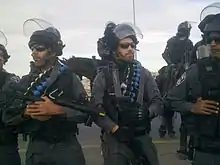A sponge grenade is a riot control weapon, intended to be non-lethal, which is fired from a 40 mm grenade launcher to cause confusion, or otherwise temporarily disable its target. As a single blunt force object, it is best used when aimed at a particular individual.

The projectile weighs about 28 grams (0.99 ounces). It is bullet-shaped, with a foam rubber nose and a high-density, plastic projectile body.

Potential for injury or death
Proper use of the weapons involves firing it from a medium distance, and aiming for the legs or lower torso.[1] Firing it too close, or firing it too far away which decreases the ability to accurately aim for the legs or lower torso, can cause serious injury.[1]
Improper use of sponge grenades can cause broken bones, head wounds, or permanent damage to eyes.[2] Sponge grenades impacting the upper body or head might have killed targeted individuals.[2][3]

Use around the world
Israel
Israel has deployed sponge grenades against Palestinian protesters on several occasions,[2] but the grenades were also used against Israeli demonstrators as well, for example, in Israeli Ethiopians protests.[4]
Hong Kong
The Hong Kong Police Force has deployed sponge grenades as a riot control tool on several occasions in July 2019 during the anti-extradition protests.[5]
New Zealand
During the fourth week of the 2022 Wellington protests against COVID-19 pandemic control measures, the New Zealand Police deployed sponge grenades as one of the many tools used in their effort to clear the parliamentary grounds of rioters.[6]
United States
Sponge grenades were used by some police departments during the George Floyd protests in the summer of 2020 and were cited as being one of the most common types of less-lethal rounds employed.[7] In some cases, protesters were struck in the head or face by the rounds, causing serious injury.[8][9]
See also
References
- 1 2 "'Less lethal' can still maim and kill: A visual guide to weapons police use on protesters". www.usatoday.com. Archived from the original on 2 February 2023. Retrieved 7 June 2022.
- 1 2 3 Haaretz Editorial (14 September 2014). "Police's Use of Sponge Rounds Must Be Strictly According to Protocol". Haaretz. Archived from the original on 5 August 2019. Retrieved 2 February 2023.
- ↑ Khalel, Sheren (14 August 2017). "Sponge rounds, rubber bullets, and tear gas — how Israel's non-lethal munitions can kill". Mondoweiss. Archived from the original on 8 October 2019. Retrieved 2 February 2023.
- ↑ מקומית, שיחה (3 May 2015). "הפגנת יוצאי אתיופיה: רימוני הלם, כדורי ספוג ועשרות פצועים ועצורים". שיחה מקומית (in Hebrew). Retrieved 5 April 2023.
- ↑ Kuo, Lily; Choi, Christy (5 August 2019). "Hong Kong protests descend into chaos during citywide strike". The Guardian. Hong Kong. Archived from the original on 8 October 2019. Retrieved 2 February 2023.
- ↑ "Bricks thrown, sponge bullets fired in Wellington unrest". Otago Daily Times. New Zealand. 2 March 2022. Archived from the original on 2 February 2023. Retrieved 3 March 2022.
- ↑ Fowers, Alyssa; Steckelberg, Aaron; Berkowitz, Bonnie (5 June 2020). "A guide to the less-lethal weapons that law enforcement uses against protesters". The Washington Post. Retrieved 6 June 2020.
- ↑ Gliha, Lori Jane. "Police projectile fractures Denver protester's face; she says it was unprovoked". KVDR FOX31 Denver. Archived from the original on 2 February 2023. Retrieved 6 June 2020.
- ↑ Gliha, Lori Jane (5 June 2020). "Lawsuit asking for Denver PD to stop using PepperBalls and sponge grenades moves to federal court". KVDR FOX31 Denver. Archived from the original on 13 September 2022. Retrieved 2 February 2023.
External links
- More data and a picture from the website of the Federation of American Scientists